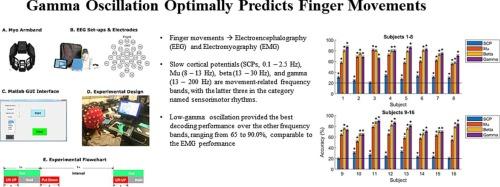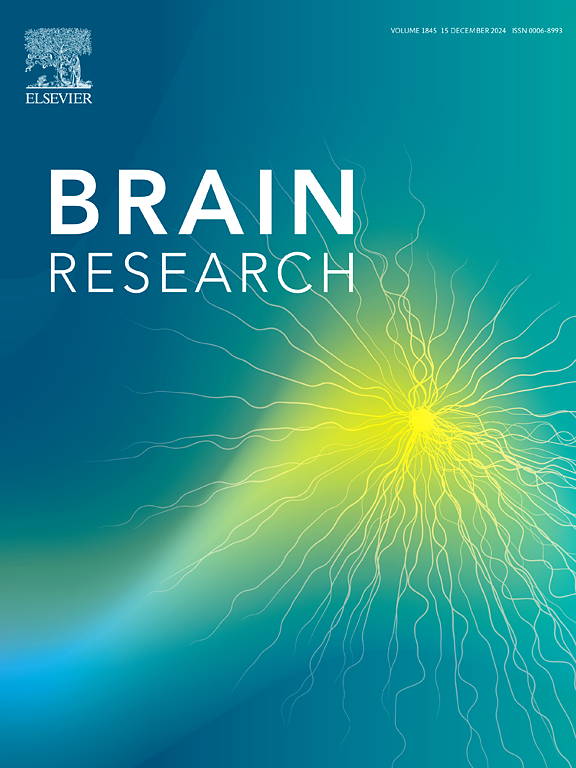Gamma oscillation optimally predicts finger movements
IF 2.7
4区 医学
Q3 NEUROSCIENCES
引用次数: 0
Abstract
Our fingers are the most dexterous and complicated parts of our body and play a significant role in our daily activities. Non-invasive techniques, such as Electroencephalography (EEG) and Electromyography (EMG) can be used to collect neural and muscular signals related to finger movements. In this study, we combined an 8-channel EMG and a 31-channel EEG while the human subject moved one of the five fingers on the right hand. To identify the best EEG frequency features that encode distinct finger movements, we systematically examined the decoding accuracies of the slow-cortical potentials and three types of sensorimotor rhythms, namely the Mu, beta, and gamma oscillations. For both EMG and EEG, we came up with a simple and unified root mean square or power approach that avoided the complex signal features used by previous studies. The signal features were then fed into a feedforward artificial-neural-network (ANN) classifier. We found that the low-gamma oscillation provided the best decoding performance over the other frequency bands, ranging from 65.0 % to 89.0 %, which was comparable to the EMG performance. Combining EMG and low gamma into a single ANN can further improve the outcome for subjects who had showed suboptimal performances with EMG or EEG alone. This study provided a simple and efficient algorithm for prosthetics that assist patients with sensorimotor impairments.

伽马振荡可最佳预测手指运动。
手指是人体最灵巧、最复杂的部位,在我们的日常活动中发挥着重要作用。脑电图(EEG)和肌电图(EMG)等非侵入性技术可用于收集与手指运动相关的神经和肌肉信号。在这项研究中,我们将 8 通道 EMG 和 31 通道 EEG 结合起来,同时让受试者移动右手五个手指中的一个。为了找出能编码不同手指运动的最佳脑电图频率特性,我们系统地检查了慢皮层电位和三种感觉运动节律(即 Mu、β 和 gamma 振荡)的解码准确性。对于肌电图和脑电图,我们采用了简单统一的均方根或功率法,避免了以往研究中使用的复杂信号特征。然后将信号特征输入前馈人工神经网络(ANN)分类器。我们发现,与其他频段相比,低伽马振荡的解码性能最好,从 65.0% 到 89.0%,与肌电图的性能相当。将肌电图和低伽玛振荡结合到一个单一的方差分析网络中,可以进一步改善仅使用肌电图或脑电图就表现不佳的受试者的结果。这项研究为辅助感知运动障碍患者的假肢提供了一种简单高效的算法。
本文章由计算机程序翻译,如有差异,请以英文原文为准。
求助全文
约1分钟内获得全文
求助全文
来源期刊

Brain Research
医学-神经科学
CiteScore
5.90
自引率
3.40%
发文量
268
审稿时长
47 days
期刊介绍:
An international multidisciplinary journal devoted to fundamental research in the brain sciences.
Brain Research publishes papers reporting interdisciplinary investigations of nervous system structure and function that are of general interest to the international community of neuroscientists. As is evident from the journals name, its scope is broad, ranging from cellular and molecular studies through systems neuroscience, cognition and disease. Invited reviews are also published; suggestions for and inquiries about potential reviews are welcomed.
With the appearance of the final issue of the 2011 subscription, Vol. 67/1-2 (24 June 2011), Brain Research Reviews has ceased publication as a distinct journal separate from Brain Research. Review articles accepted for Brain Research are now published in that journal.
 求助内容:
求助内容: 应助结果提醒方式:
应助结果提醒方式:


